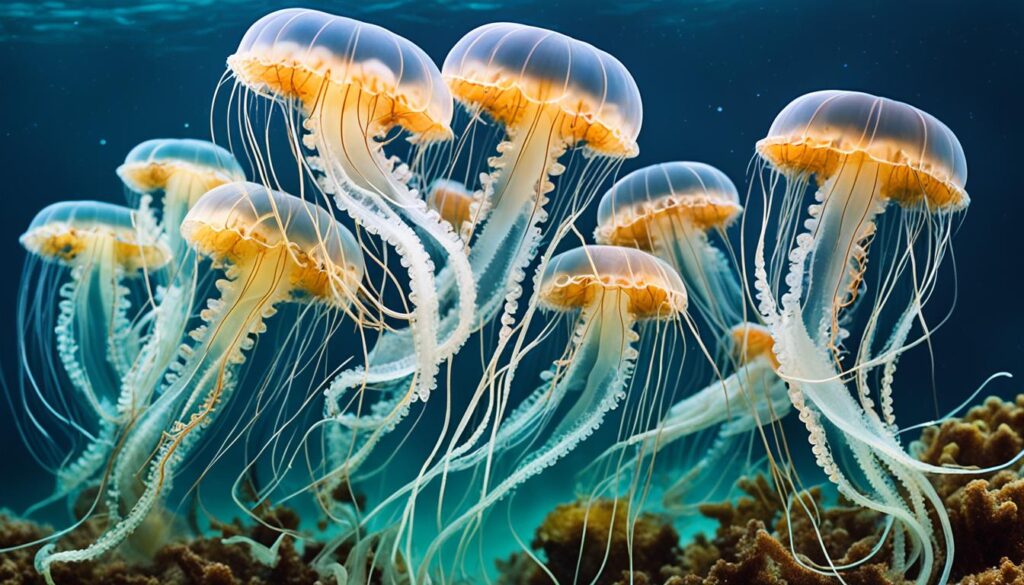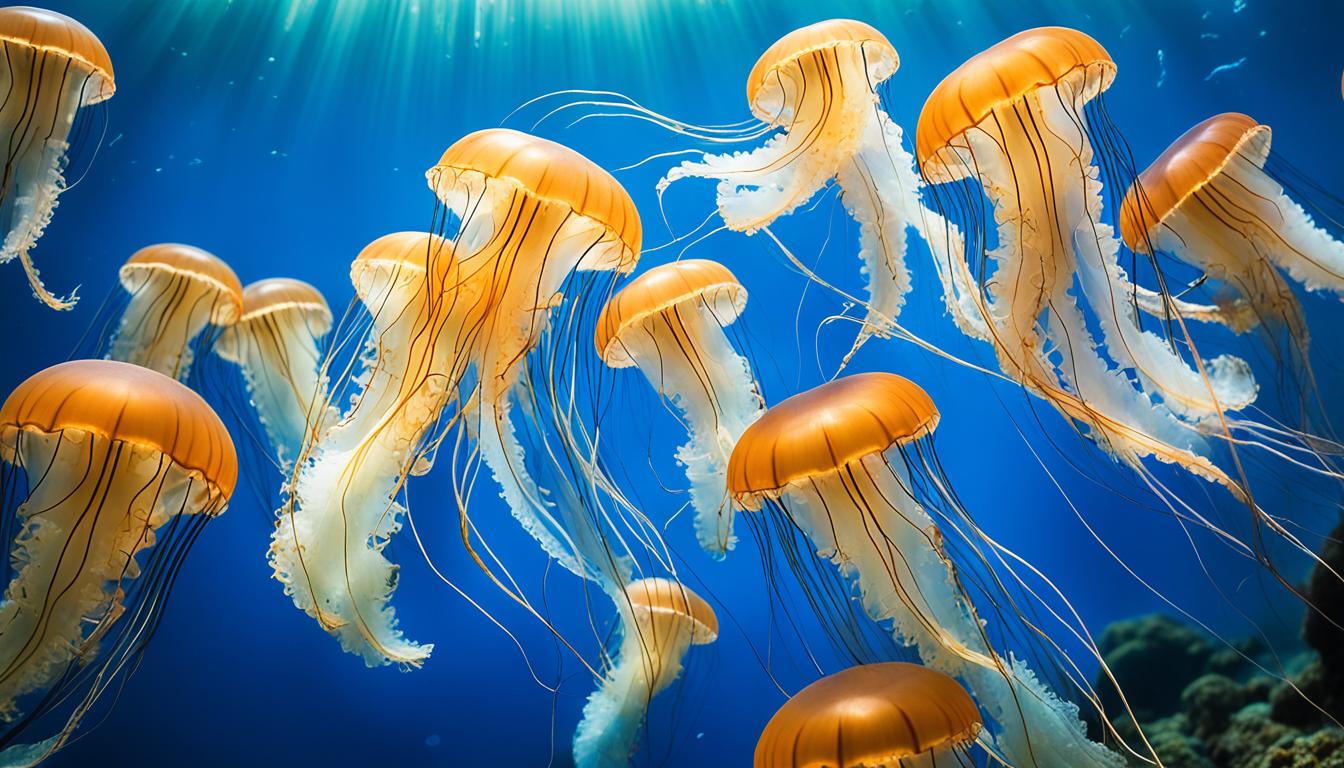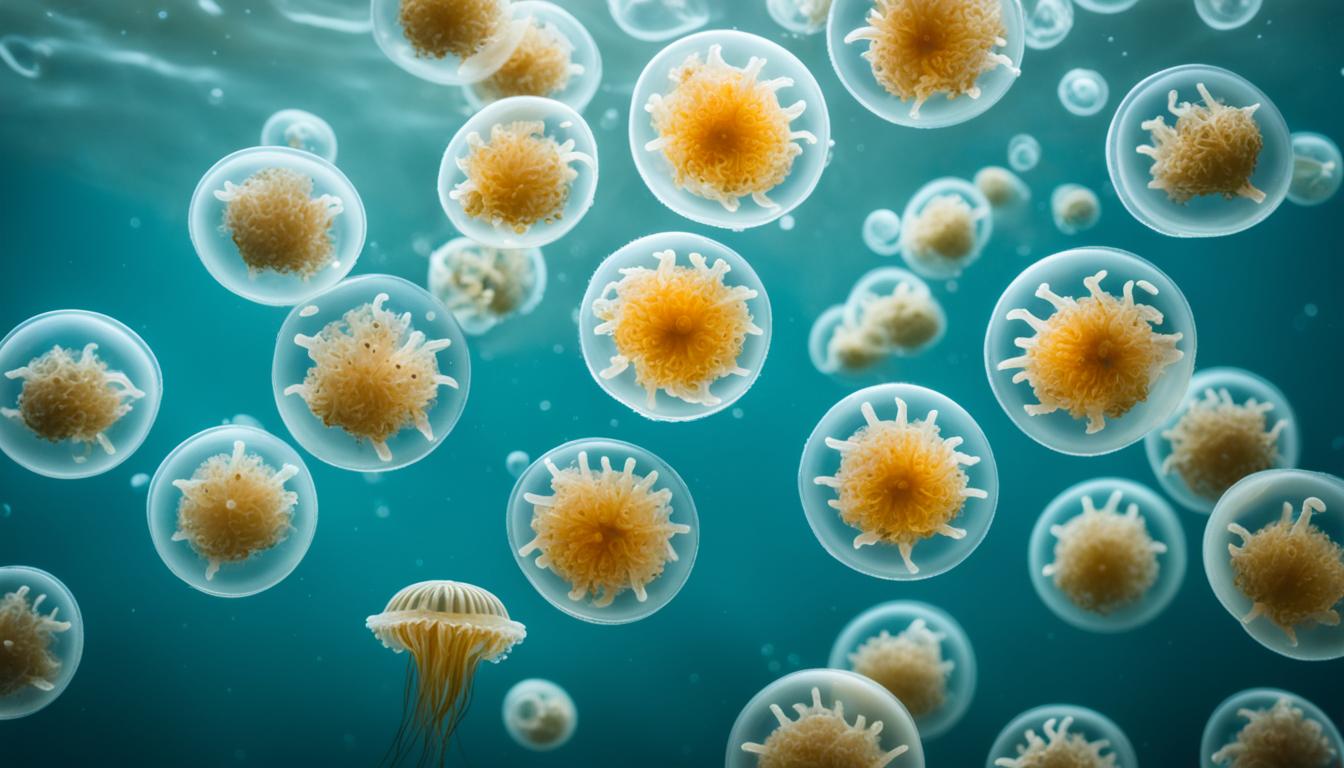Welcome to the fascinating world of jellyfish! In this guide, you’ll explore the diverse species of jellyfish in our oceans. It’s important to know about the different types of jellyfish and their unique features. This knowledge is key for marine lovers and helps us understand their role in the ocean.
Jellyfish belong to the phylum Cnidaria and come in many varieties. Each type is classified by its traits and where it lives. In this article, we’ll cover the main differences between jellyfish, how to identify them, and their cultural importance. Let’s dive into the world of jellyfish classification together!
Understanding Jellyfish Classification
Jellyfish classification is all about grouping these amazing sea creatures by their looks. This way, we can spot different types and see how they fit into their ocean homes. Jellyfish are split into scyphozoans, hydrozoans, and cubozoans, each with its own special traits like shape, size, and color.
Overview of Jellyfish Varieties
There are many jellyfish species, each one different in looks and actions. Here are some main types:
- Scyphozoans: These have a classic umbrella-shaped bell.
- Hydrozoans: They can be polyps and live in many places.
- Cubozoans: Known for their cube-shaped bodies and strong venom.
Knowing about these groups helps scientists study jellyfish better. It helps them learn about their lives and where they live.
Importance of Jellyfish in Marine Ecosystems
Jellyfish are key to ocean life. They eat and are eaten by other sea creatures, keeping the food chain balanced. They also affect the numbers of fish and plankton. Plus, they help break down nutrients in the sea.
By understanding jellyfish’s role, we see how vital they are for the ocean’s health.
What are the different types of jellyfish?
Jellyfish come in many shapes and sizes, making them very interesting to learn about. Knowing the different types helps us appreciate these sea creatures more. They have unique features, colors, and ways to live in various places.
Distinct Characteristics of Jellyfish Species
Each jellyfish has special traits that help it live in its home. These traits include:
- Anatomy: Jellyfish have a bell-shaped body, tentacles, and a mouth under the bell. Some have special tentacles for catching food.
- Coloration: Jellyfish can be clear or brightly colored. Clear ones blend in, while bright ones warn predators or attract mates.
- Adaptations: Many have special features like glowing to avoid predators or draw in food, showing how they’ve adapted to survive.
Geographic Distribution of Jellyfish Varieties
Jellyfish live in many places, from oceans to other water bodies. You’ll find them in:
- Coastal Waters: Shallow, warm areas are home to many jellyfish, where they find plenty of food.
- Open Oceans: Some, like the Moon Jellyfish, live deep in the ocean, showing how they can adapt to different depths.
- Seasonal Migration: Some move closer to shore during certain times for breeding and eating.

This look into jellyfish shows their amazing variety and important role in the ocean. It tells us a lot about their lives and how they adapt to the sea.
Notable Jellyfish Species to Explore
Exploring the world of jellyfish shows us the amazing variety of marine life. This list highlights some of the most interesting jellyfish. Each one has unique traits that help them live in the ocean.
Box Jellyfish (Chironex fleckeri)
The Box Jellyfish is known for its deadly venom. It lives in the Indo-Pacific and can grow up to ten feet long. Its sting can be very painful and even dangerous to humans. If you get stung, you need medical help right away.
Moon Jellyfish (Aurelia aurita)
The Moon Jellyfish is a beautiful jellyfish found in coastal waters. It has a translucent bell and a mild sting, so it’s not a threat to swimmers. It can grow to be 12 to 16 inches wide and has four visible gonads. People often see them in aquariums because they look so otherworldly.
Sea Nettle (Chrysaora fuscescens)
The Sea Nettle is known for its bright colors and long tentacles. It lives along the east coast of North America and grows up to 30 inches wide. Its sting hurts, but it’s not deadly. These jellyfish are an important food source for many other sea creatures.
Portuguese Man-of-War (Physalia physalis)
The Portuguese Man-of-War looks like a jellyfish but is actually a group of different parts working together. Its gas-filled float can be up to 12 inches long. Found in warm waters, its tentacles can sting and hurt. But it’s not usually deadly, so you just need to be careful.
| Jellyfish Species | Size | Habitat | Danger Level |
|---|---|---|---|
| Box Jellyfish | Up to 10 feet | Indo-Pacific waters | High |
| Moon Jellyfish | 12 to 16 inches | Coastal waters | Low |
| Sea Nettle | Up to 30 inches | North American east coast | Moderate |
| Portuguese Man-of-War | Up to 12 inches | Warm ocean waters | Moderate |
Jellyfish Identification Guide
Knowing how to spot jellyfish is key for those who love the sea and beach lovers. Spotting jellyfish depends on noticing their unique looks. This knowledge helps you know what to do when you meet these interesting sea creatures.
Physical Attributes for Identification
Jellyfish look different, which helps us tell them apart. Here are some important things to look for:
- Bell Shape: The bell’s shape and size are key. It can be dome-shaped or like an umbrella, depending on the type.
- Color: Jellyfish come in many colors, from clear to bright, and some glow in the dark.
- Tentacle Structure: The tentacles vary in number, length, and how they’re arranged, helping to identify them.
How to Distinguish Jellyfish in Different Waters
Here are tips for spotting jellyfish in different places:
- Look at the local sea life. Some jellyfish live in certain areas and times of the year.
- Notice the size and color of jellyfish, as they change with their surroundings.
- Learn about the common jellyfish in your area and their unique traits.
Using these tips will make you better at dealing with jellyfish safely and wisely. Below is a table with some common jellyfish and their main features.
| Jellyfish Species | Bell Shape | Color | Tentacle Structure |
|---|---|---|---|
| Moon Jellyfish | Flat, umbrella-like | Translucent purple | Short, thin tentacles |
| Box Jellyfish | Cuboidal | Colorless or pale blue | Long, stinging tentacles |
| Sea Nettle | Bell-shaped | Yellow to brown | Long, trailing tentacles |
Jellyfish in Popular Culture and Research
Jellyfish have always caught our attention, appearing in art, literature, and movies. They are seen as graceful and mysterious, yet their stinging tentacles can also bring fear. From Disney’s “Finding Nemo” to classic literature, they show both beauty and danger.
This interest goes beyond just fun and movies. Scientists are now studying jellyfish to learn more about their role in nature. They want to understand how jellyfish numbers change and their effect on the ocean. With overfishing and climate change affecting the sea, knowing about jellyfish is key.
These creatures are not just floating in the water. They can change fish populations and compete for food, affecting the ocean’s balance. By joining citizen science projects, you can help with jellyfish research. Your efforts can help protect these fascinating creatures and their homes.









